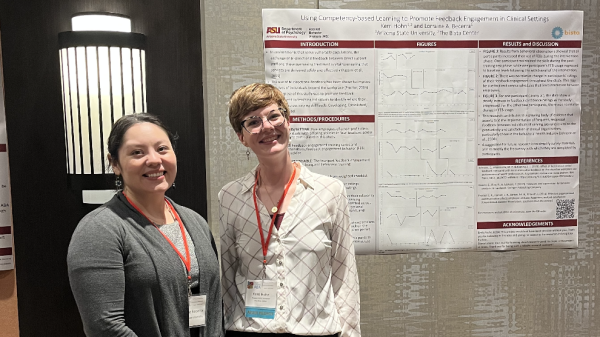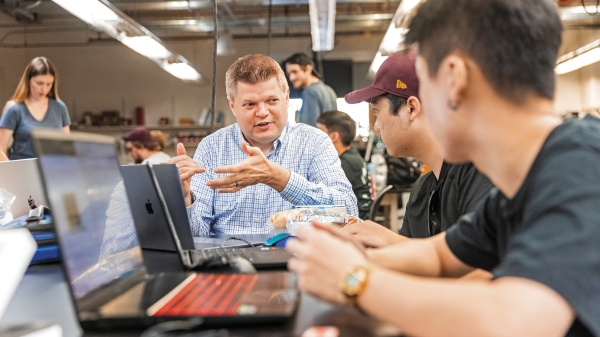A great passion for the great outdoors
As conservation biology pioneer Andrew Smith enters final year at ASU, student praise and industry accolades hail his career

After he arrives in the desert with his students, everyone pitches camp. The students yell and falter at setting up their tents.
They’re not pros, yet. The students set up their tents close, a bit too close (they’re not going to enjoy others’ snoring and late-night conversations), facing all directions (if they face east, they’d wake with the sun) and on questionable ground.
The professor — who has been a backpacker since he was 9 — is an old hand at this. He has his tent up and bedroll inside it within minutes. He’s by himself and a good 100 yards from the fire — he'll sleep in peace. And he'll sleep dry on a slope (it’s unlikely to rain, but experience is what you get when things go wrong). His tent faces east; there won't be any lingering in the morning.
These tiny details belie a master outdoorsman. You can tell a lot about a man by how he pitches camp.
You can also tell a lot about a man by how he teaches. The springtime camping trip was part of a tradition for Arizona State University conservation biologist Andrew Smith: After each Biology 410 course he taught, Smith took students out in the field to share his love of animals and of working in their habitats.
A lifetime of passion and research has garnered Smith — a President’s Professor and Parents Association Professor in the School of Life SciencesThe School of Life Sciences is an academic unit of the College of Liberal Arts and Sciences. Smith is also a distinguished sustainability scientist in the Julie Ann Wrigley Global Institute of Sustainability. — the Aldo Leopold Award from the American Society of Mammalogists, which he received this summer. The Leopold award is given to scientists who have made lasting contributions to the conservation of mammals and their habitats.
“In total, Dr. Smith’s research, mentoring, program building and outreach activities over the past three decades have significantly impacted the conservation of mammals (and other organisms) in one of the most impacted regions of our planet,” the society said in a statement about Smith’s award.
Famous conservationist and award namesake Aldo Leopold once wrote, “There are some who can live without wild things and some who cannot.” He may well have been speaking about Smith.
“I know where my animals are,” Smith said recently, discussing the whereabouts of pikas — the animal on which he is a world expert — in the Sierra Nevadas during California’s record drought, but he could have been talking about any of the huge range of mammals with which he is familiar.
He not only knows where they are, but what they’re doing at any given moment. Sometimes he knows what they’re thinking — that a kit fox released from a trap in the desert will run 150 feet away, stop and look back, “because that’s what they do.”
“There were always interesting questions to ask, and there are still interesting questions to ask.”
— ASU President's Professor Andrew Smith, on conservation biology
Smith — who incidentally took a wildlife conservation class at the University of California Berkeley in the late 1960s taught by the son of Aldo Leopold — started at ASU in 1978. He will retire at the end of the 2016-2017 school year.
Back when the young Southern Californian took his class with A. Starker Leopold, he wrote his first research paper on the pika as a part of the class. Pikas are adorable animals about the size of a tennis ball that live in the mountains high above tree lines. When they call out, they sound like a dog’s squeaky toy.
After taking the class, Smith noticed that in every book about North American mammals, the entry under pika read, “Nothing is known about pikas.”
“That was part of it,” he said of his choice of subject to study for the rest of his life.
Another class he took as an undergrad on how species regulate body temperatures sealed the deal. Plus, he realized he could backpack, fish and work, all at the same time.
“Yes, I could fish while I was gathering data,” he said. A true field man, he has spent innumerable hours roaming the Tibetan plateau and the mountain ranges of the West. He can’t understand ecological researchers who spend their careers inside labs data modeling.
“There were always interesting questions to ask, and there are still interesting questions to ask,” he said of his work.
ASU was the first university to offer a conservation biology degree. Smith started it.
He saw a need for it and wanted a systems approach, rather than simply wildlife management, which was in vogue at the time.
“We weren’t a big-game type of operation or anything like that,” he said. “Conservation biology seemed to me a bigger umbrella incorporating socio-economic, political, local peoples, cultural mores, all those different aspects, and ethics, into resource management. It seemed like a much bigger fit for the kinds of things we did. ... What’s really great is that it’s expanded, and there are lots of conservation biology degrees.”
The society called “the development and implementation of one of the first formal Conservation Biology degrees nationwide, a feat that surely would have made Aldo very proud.”
ASU conservation biologist Andrew Smith (in his office on the Tempe campus) is a world expert on the pika, a tiny mammal with short limbs, very round body and rounded ears. He proved that the pikas are a keystone species in their rangeland habitat in China and Tibet. Photos by Charlie Leight/ASU Now
A conversation with Smith led undergrad Jess Givens to pursue a bachelor's in conservation biology and ecology and to become president of the Central Arizona chapter of the Society for Conservation Biology.
“Dr. Smith is not only a phenomenal field biologist, but a magnetic teacher and mentor,” Givens said. “Beyond equipping us with skills or ideas, Dr. Smith deeply cares that we walk out of his field or lecture classes as more thoughtful students ready to ask important questions. His wealth of knowledge from his travels and research experiences make him a truly one-of-a-kind teacher, scientist and friend in the life sciences. I feel incredibly grateful to have been taught and mentored by a living legend.”
Smith was a doctoral adviser to Jesse Senko, who worked as a teaching assistant in two of his classes. Senko is a postdoctoral research associate.
“Andrew selflessly agreed to take me on as his PhD student after I left my original lab at ASU, even though he was nearing retirement,” Senko said. “In addition to his extraordinary mentorship, Andrew was able to inspire, empower and instill an extraordinary sense of confidence in me, both as a conservation research scientist and teacher.
“Whether meeting with graduate and undergraduate students for hours on end in his office or chatting with students beside a campfire on one of his famed field trips, Andrew’s seemingly effortless ability to mentor students is truly unparalleled in academia. ... Perhaps his greatest gift is his ability to show his students how much he cares.”
Senko also remains impressed that “he, as an alpine mammal biologist, took me on, a marine biologist who studies sea turtles and fisheries, and did an extraordinary job to boot!”
Andrew Smith takes his students on a last camping trip this spring.
Smith’s impact goes beyond the classroom, as the Leopold award noted. Years ago he wrote a paper suggesting volunteer specialist groups overlay their data and concepts so they could work together. It would work like a geographic information systems map, with layers of habitats, species and data.
This was before computers became what they are now. Smith and a colleague from Rome plugged away at it.
“We figured we couldn’t quit because we were volunteers,” he said. “After about 10 or 15 years, we finally got them blended together, and computers caught up.”
Now, the Species Information Service has become the data management system used to capture data for the Red List of the International Union for Conservation of Nature. The Red List usually appears in the news as a headline that something is on the verge of extinction. The IUCN is the largest professional global conservation network, with almost 11,000 scientists volunteering.
“My initial vision was right, and it’s what the system is now,” Smith said. “Most people who use it now don’t even know I ever existed. I felt really proud of getting that started, and pushing really hard and having the stubbornness to stay with it. That was something I’m really proud of.”
“Stubborn” describes his persistence in his work in China and Tibet studying pikas. He has written hundreds of papers on the pikas and their rangeland habitat. He proved that the pikas are a keystone species in the area — a species that, if it disappeared, would change the entire ecosystem dramatically.
The Chinese government poisons pikas because they think they cause erosion.
“There’s no experimental data — none,” Smith said. He learned that when pikas are poisoned, their burrows collapse, livestock compact the soil and increase the chances of runoff, erosion and flooding. When pika burrows exist, water is released more slowly, decreasing runoff, erosion and flooding.
Smith’s work convinced his Chinese colleagues to write papers and push the government to stop poisoning pikas. They have stopped some poisoning.
“We’ve had a few uphill victories,” he said.
The society thought highly of his work there. “His strong advocacy for conservation of lagomorphsLagomorphs include rabbits, hares and pikas. worldwide, but especially on the Tibetan Plateau, provide a wonderful model of what is possible when scientists apply their research skills, determination, and knowledge to help shape conservation policy,” they said in describing the reason for his award.
As part of winning the award, Smith gave the plenary speech at the annual meeting last month. He spoke on the need to do good science in order to do good conservation, citing the pika as an example. Everyone from grizzled field biologists to bright-eyed young postdocs congratulated him. A grad from his alma mater — Berkeley — named Talisin Hammond even drew a poster from his talk while he spoke and presented it to him afterwards (pictured below).
“It was incredibly well-received,” Smith said. “I’ve never had more positive feedback in my entire career than I had (at the meeting). … It was the most incredible professional experience of my life.”
He will teach in the fall and officially retire in May. He is finishing a book on conservation in China.
“I’m winding down — I’m not done,” he said. “I’m going to keep going. I just won’t have to go to meetings. ... I’m going to continue working — absolutely.”
And he will fish. “Sure,” he said with a smile. “At least backpacking in the Sierras.”
More Science and technology

Miss Arizona, computer science major wants to inspire children to combine code and creativity
Editor’s note: This story is part of a series of profiles of notable spring 2024 graduates. “It’s bittersweet.” That’s how Tiffany Ticlo describes reaching this milestone. In May, she will graduate…

ASU applied behavior analysis program recognized in Four Corners region
Helping students with learning disabilities succeed in school and modeling effective communication skills are just two examples of how applied behavioral analysis improves lives. Since launching…

Redefining engineering education at West Valley campus
Editor's note: This story originally appeared in the summer 2024 issue of ASU Thrive magazine. What makes the School of Integrated Engineering different from other engineering schools? We listened…